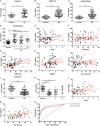Clinical Relevance of Galectin-1 and Galectin-3 in Rheumatoid Arthritis Patients: Differential Regulation and Correlation With Disease Activity
- PMID: 30687310
- PMCID: PMC6333668
- DOI: 10.3389/fimmu.2018.03057
Clinical Relevance of Galectin-1 and Galectin-3 in Rheumatoid Arthritis Patients: Differential Regulation and Correlation With Disease Activity
Abstract
Galectins, a family of animal lectins, play central roles in immune system regulation, shaping both innate and adaptive responses in physiological and pathological processes. These include rheumatoid arthritis (RA), a chronic multifactorial autoimmune disease characterized by inflammatory responses that affects both articular and extra-articular tissues. Galectins have been reported to play central roles in RA and its experimental animal models. In this perspective article we present new data highlighting the regulated expression of galectin-1 (Gal-1) and galectin-3 (Gal-3) in sera from RA patients under disease-modifying anti-rheumatic drugs (DMARDs) and/or corticoid treatment in the context of a more comprehensive discussion that summarizes the roles of galectins in joint inflammation. We found that Gal-1 levels markedly increase in sera from RA patients and positively correlate with erythrocyte sedimentation rate (ERS) and disease activity score 28 (DAS-28) parameters. On the other hand, Gal-3 is downregulated in RA patients, but positively correlates with health assessment questionnaire parameter (HAQ). Finally, by generating receiver-operator characteristic (ROC) curves, we found that Gal-1 and Gal-3 serum levels constitute good parameters to discriminate patients with RA from healthy individuals. Our findings uncover a differential regulation of Gal-1 and Gal-3 which might contribute to the anti-inflammatory effects elicited by DMARDs and corticoid treatment in RA patients.
Keywords: autoimmune disease; galectin-1; galectin-3; inflammation; rheumatoid arthritis.
Figures


Similar articles
-
A decrease in galectin-1 (Gal-1) levels correlates with an increase in anti-Gal-1 antibodies at the synovial level in patients with rheumatoid arthritis.Scand J Rheumatol. 2013;42(2):102-7. doi: 10.3109/03009742.2012.725769. Epub 2012 Dec 18. Scand J Rheumatol. 2013. PMID: 23244209
-
Galectin-9 as an indicator of functional limitations and radiographic joint damage in patients with rheumatoid arthritis.Front Immunol. 2024 Jun 18;15:1419676. doi: 10.3389/fimmu.2024.1419676. eCollection 2024. Front Immunol. 2024. PMID: 38957462 Free PMC article.
-
Differential regulation and correlation between galectin-9 and anti-CCP antibody (ACPA) in rheumatoid arthritis patients.Arthritis Res Ther. 2020 Apr 15;22(1):80. doi: 10.1186/s13075-020-02158-3. Arthritis Res Ther. 2020. PMID: 32293530 Free PMC article.
-
Serum Galectin-3 Level in Patients with Rheumatoid Arthritis: A Systematic Review and Meta-analysis.Iran J Allergy Asthma Immunol. 2024 Oct 6;23(5):476-488. doi: 10.18502/ijaai.v23i5.16777. Iran J Allergy Asthma Immunol. 2024. PMID: 39586742
-
Therapeutic Potential of Galectin-1 and Galectin-3 in Autoimmune Diseases.Curr Pharm Des. 2022;28(1):36-45. doi: 10.2174/1381612827666210927164935. Curr Pharm Des. 2022. PMID: 34579628 Review.
Cited by
-
Roles of circular RNAs in immune regulation and autoimmune diseases.Cell Death Dis. 2019 Jun 26;10(7):503. doi: 10.1038/s41419-019-1744-5. Cell Death Dis. 2019. PMID: 31243263 Free PMC article. Review.
-
A Dynamic Interplay of Circulating Extracellular Vesicles and Galectin-1 Reprograms Viral Latency during HIV-1 Infection.mBio. 2022 Aug 30;13(4):e0061122. doi: 10.1128/mbio.00611-22. Epub 2022 Aug 9. mBio. 2022. PMID: 35943163 Free PMC article.
-
Elevated serum galectin-1 concentrations are associated with increased risks of mortality and acute kidney injury in critically ill patients.PLoS One. 2021 Sep 24;16(9):e0257558. doi: 10.1371/journal.pone.0257558. eCollection 2021. PLoS One. 2021. PMID: 34559847 Free PMC article.
-
Serum levels of Galectin-1 and Galectin-3 for monitoring rheumatoid arthritis severity: a meta-analysis.Am J Transl Res. 2025 May 15;17(5):3252-3260. doi: 10.62347/XGUP6698. eCollection 2025. Am J Transl Res. 2025. PMID: 40535668 Free PMC article. Review.
-
Galectin-1 as a potential biomarker of rheumatoid arthritis drug effectiveness.Int J Immunopathol Pharmacol. 2025 Jan-Dec;39:3946320251358305. doi: 10.1177/03946320251358305. Epub 2025 Jul 18. Int J Immunopathol Pharmacol. 2025. PMID: 40682289 Free PMC article.
References
Publication types
MeSH terms
Substances
LinkOut - more resources
Full Text Sources
Medical
Research Materials

